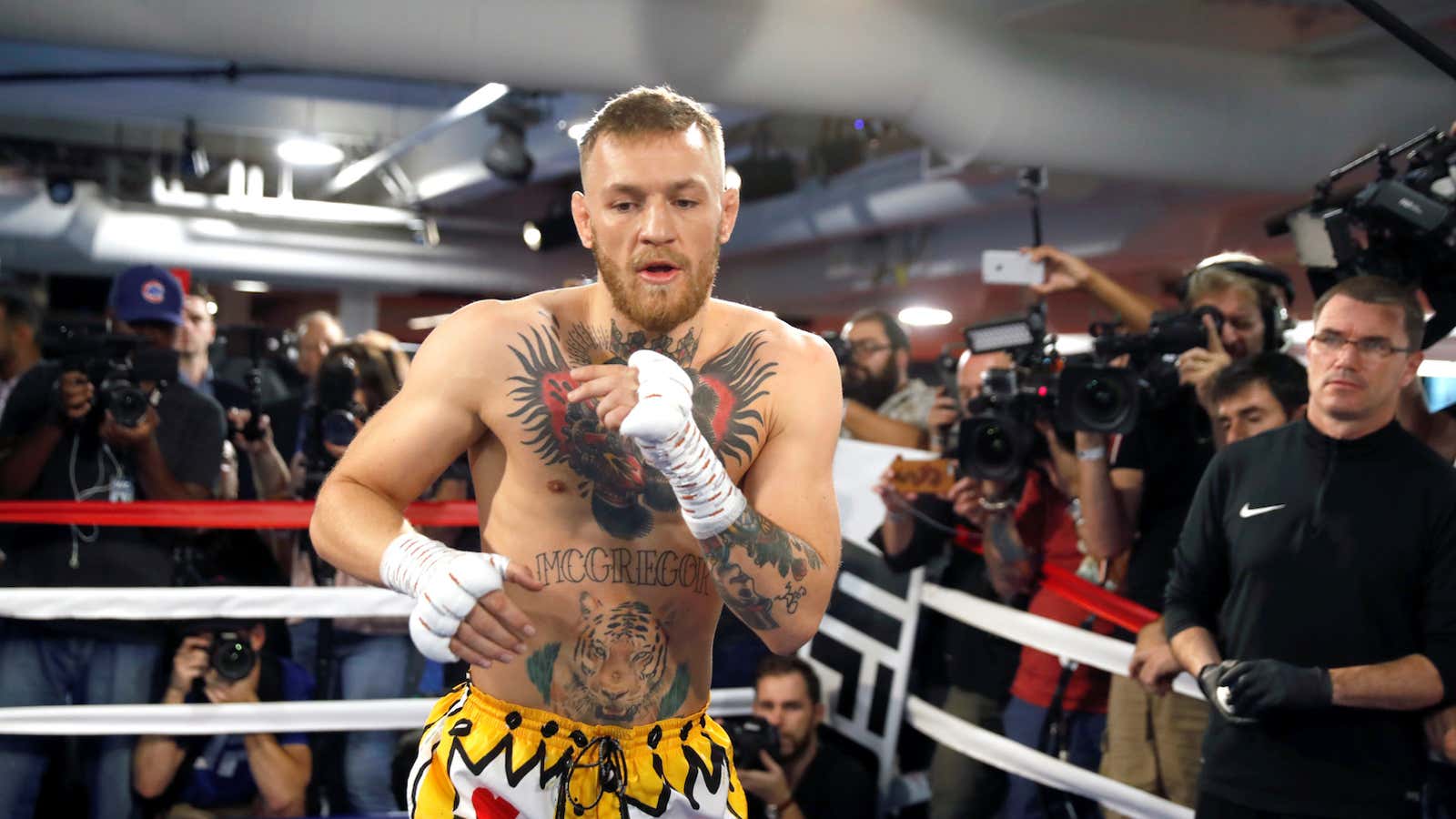Conor McGregor, boxing novice, takes on Floyd Mayweather on Saturday in what is shaping up to be the biggest fight in history. Both men are promising that neither will make it depend on the judges’ scorecards. But what if they have to fight for the full 12 rounds? (Mayweather’s last seven fights, going back to 2011, have gone the distance.)
In mixed-martial arts (MMA), McGregor is used to training for fights of five rounds of five minutes each, with a minute’s rest between. He has some experience in amateur boxing, which until 2009 was three or four two-minute rounds. On Aug. 26, McGregor will face the standard of professional boxing—12 rounds of three minutes, with a minute’s rest. That’s also a potential of 36 minutes of pure fighting vs. 25 in the UFC.
The difference can also been seen in recent fights for both combatants. In Mayweather’s last bout, against Andre Berto, he threw 410 punches, of which 56% landed. And 132 of those hits were power punches. In McGregor’s brawl last year with Nate Diaz—which lasted the full five rounds and featured a lot of stand-up punching—he threw 286 significant shots and landed 164, according to FightMetric.
It’s just a different work rate. There’s more fighting in boxing, and also more rest. (It works out to a work-to-rest ratio of 3:1 in boxing, versus 5:1 in MMA.)
And that is before you get into the differences in the sports themselves. In MMA, you can punch, hit, and grapple. Boxing has only punching. “MMA fighters typically don’t move their heads,” says Heather Hardy (paywall), who fights both as a boxer and in MMA. “They are not as evasive as boxers. Like anything else, it is way easier to knock out a stationary target than something that is moving all over the place. I’ve seen Mayweather crouch so low that his ass almost hits the canvas.”
Moving your head, punching constantly, hitting the air when you miss; these things are tiring. MMA fighter Michael “Venom” Page, who is transitioning to boxing, told the Independent of how both sports impact his body:
We don’t have as much specific work on our arms and our shoulders. The struggle for me is the endurance, the muscular endurance and being able to be able to do it for such a long period of time. In MMA, if my arms are a little tired, I can clinch, I can go for a takedown or use my kicks…
It’s just later on [in the fight] when the strength of boxers shines through. I know for a fact that my shoulders will tire out and they still have the power in their arms because they’ve been training for this a lot longer then I have. This is different.
The concepts of “rounds” took a long time to become part of boxing, which once looked a lot like how MMA does now. The original “Broughton’s rules” of boxing from 1743 banned eye-gouging but tolerated pretty much everything else, including bare-knuckle beatdowns. In the 1830s, the London Prize Ring Rules banned kicking and head-butting, but still fighters could throw each other around and there were no set periods. Fighters fought until someone was knocked down, which was the end of the round; the fighter got a 30-second break to recover, at which time the next round would begin. The bout went until someone did not come back into the center of the ring.
Boxing, as we know it, evolved around 1865 with the introduction of the Marquis of Queensbury rules, which created three-minute rounds, a minute’s rest, and the standing 10-count in the event of a knockdown. It also introduced the padded leather glove—the weight of which is still a determining factor in a fight. “The new rules outlawed wrestling,” Arne K. Lang wrote in Prizefighting: An American History. “The mediocre boxer with a mean cross-buttocks throw had no future in the Queensbury game.”
By all accounts, McGregor would have liked the old ways very much. But could even he have stomached it? In 1888, Jake Kilrean fought John L. Sullivan in the last bare-knuckle heavyweight match ever, according to Gerald R. Gems’s Boxing: A Concise History of the Sweet Science. The fight took place in Mississippi in temperatures exceeding 100°F (37°C).
It lasted 75 rounds.
